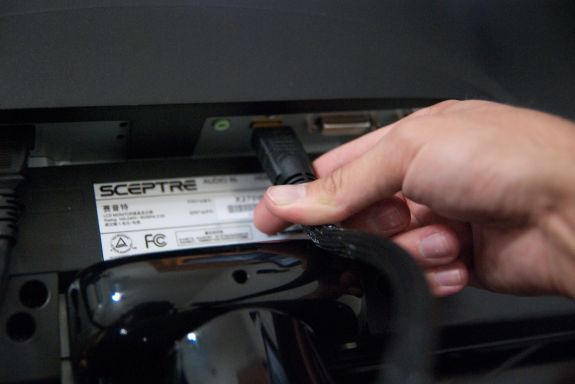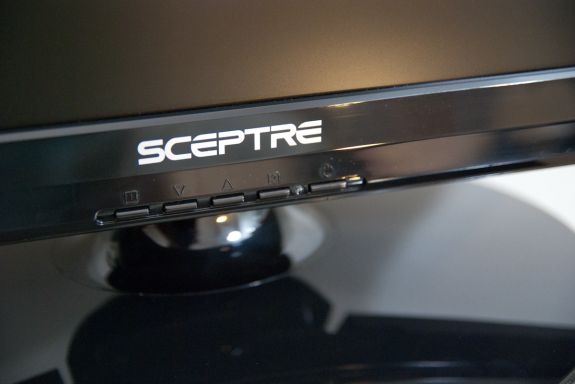Sceptre X270W-1080P Review: A Value 27" That Delivers
by Brian Klug on May 17, 2010 10:22 PM ESTAppearances and Impressions
Out of box, the Sceptre is imposing (though not so much that you’d want to use it as an ornamental staff). That said, there’s no arguing that 27” isn’t monstrous for an LCD display. Packaging is sufficient and of the styrofoam kind - extracting the big panel isn’t a problem, and doesn’t seem to lend itself to being damaged easily.
The display stand is basic - assembly consists of sliding the panel into one piece which then snaps into the circular plastic base. It’s sufficient to hold the display firmly in place, but doesn’t offer any ergonomic options outside of vertical tilt, about 20 degrees is all you get. Keep in mind on a large panel a small amount of tilt feels like a lot because of how much motion there is out at the extreme, but the 20 degrees of travel here lets you get between perfectly vertical, and comfortably tilted upward. There isn’t any height adjustment, swivel, or rotation. The option (tilt) you get is spartan, but the display stand feels firm and works adequately enough that typing on the same desk doesn’t result in some monitor shake starting. That weird kind of monitor tilt resonance can get really annoying, especially on cheaper display stands. There’s a standard 100mm VESA mount, so you can bring your own better stand if you so choose.
Tight Connector Clearance
My only major complaint with the physical design of the Sceptre is that making connectors are given surprisingly little clearance on the back panel. Connecting my relatively chunky dual link DVI cable to the X270W, I had to bend the cable a bit sharply for it to clear the plastic stand. The single link cable supplied in-box has a noticeably smaller connector, so you won’t run into this issue if you use theirs, but be careful if you’ve got some pre-run, fatter DVI-D cables like mine.
Things got a bit worse with the HDMI cables I had on hand, which admittedly have over-engineered cable strain relief and cause all sorts of problems on other displays - these didn’t fit at all and certainly would’ve broken the port inside if I shoved any further. I guess what I’m getting at is that it’d be nice to see a cable management clip or some routing guidance here, and no obstruction preventing you from bringing any cable down and out. At the end of the day, I wound up grabbing some other HDMI cables.
We’ve already talked about the 1080P display resolution and subsequent 16:9 aspect ratio choice. There’s not much to be said other than that 1920x1200 is quickly becoming the exception to the rule, whether you like it or not. For a monitor packing HDMI which will likely be driven at HD resolutions, there’s definitely an argument in favor of 16:9.
The front panel has the OSD controls centered below the Sceptre logo - there are 5 buttons. Four for navigation, one for power. We’ll talk about the OSD menus at the end of the review, but Sceptre’s options are again a bit spartan and just a little confusing - especially for changing volume, but we’ve seen them before.
Power on lag is respectable - from cold boot to 1080P HDMI display in just over 10 seconds. Switching inputs is very fast - nearly instantaneous. The rest of the controls are responsive, though in HDMI mode it does seem like the menus occasionally were a bit slower than over DVI.
Viewing angles are the standard news for a TN panel - very good until you’re viewing the display at an extreme angle. In fact, the only notably bad angle (as with most TNs) is at an extreme negative angle, viewing the monitor from below. Again, that’s to be expected.
All important display quality isn’t perfect out of box, but gets surprisingly good after you calibrate and tune the display’s somewhat outmoded OSD. We did discover one unobtrusive dead pixel, though it seems to come in and out of being a problem.
Overall first impressions are pretty good: The X270W does what it’s supposed to do, and as we’ll see later, does a relatively good job tracking colors and being uniform. It’s a mammoth display, but again dot pitch is a bit bigger than we’re used to.



















61 Comments
View All Comments
Ninjahedge - Wednesday, May 19, 2010 - link
Erp,I know why. i have been doing the multipliocation about desktop space, but the thing is also this.
When you get 2 stands, 2 usb hubs, 2 power supplies and 2 of every other piece of support equipment included on two seperate 1600x1200 screens AND you are able to buy each for $400 and $450 through special offers 3-5 YEARS ago, you wonder why some of these computer monitors still feel they need to MSRP at $1400 ($1200 on sale if you are lucky).
I know the resolution is better than a TV, but I am starting to see TV's creep down below $1000 for 1080p sets at 120Hz.....
Am I chastizing the companies for charging so much? No. It just gets annoying to see a slew of 1080's for $300-$500, but as soon as you bump a little above it the price soars in a non-linear fasion on a technology that is far from new.
Toilet Duck - Tuesday, May 18, 2010 - link
Here is a pretty nice Acer with an adjustable and sturdy base that Ive bought for a few work systems:http://www.newegg.com/Product/Product.aspx?Item=N8...
Necrosaro420 - Wednesday, May 19, 2010 - link
juzz86, I have the EXACT same monitor, and I have 2 lines that pop up on mine as well, started a little over a year after I purchased it, and they are on the right hand side, but are not quite 1/2 thick, more about 1/8th. And yep after it warms up, they go away.juzz86 - Wednesday, May 19, 2010 - link
It's a strange issue hey? Must have something to do with the brand of panel used. It would be interesting to see whether owners of other S-PVA models had experienced the same thing, or whether it is just limited to the 2408WFP. Should get some kind of poll/thread going!ReaM - Wednesday, May 19, 2010 - link
Hey, have you guys read about Dell releasing new 21 and 23 inch IPS Monitors?Crappy is that they are also 1080.
Cmon, man, I had a 1280x1024 since like 2002 and there is still not much improvement with that 1080p.
I even could work with 1600x1200 on the CRT, but the symbols in WinXP were too small.
Let's make a pact. We shall refuse to buy 1080 monitors. They should really vanish off the shelves!
I have nothing against 16:9, if it had 1200 vertical lines, but 1080 is a step back.
anactoraaron - Friday, May 21, 2010 - link
I have 2 of these and one D300s. With the D300s, you could get 1/1250th at 2.8 and not have to deal with the lack of color accuracy (not to mention the grainy images). You should go out and make a "business" purchase of a D300s, they cost twice what the D80 was new and there is just no comparison.sviola - Monday, May 24, 2010 - link
Hey Brian,You could do a review on 23"+ 120 Hz monitors there are two that have been recently released (one from Acer and one from Alienware) and there are more in the way (from LG, Samsung and Asus).
ProDigit - Monday, May 24, 2010 - link
Hi,After looking a bit around, I as well would love to have this same review of this monitor versus the Samsung P2770HD.
That monitor has a built in TV tuner, and has a remote control, and better speakers, reasons enough for me to pay the $70 surplus!
So far, the spectre of this article doesn't seem to be a bad buy, that is if you are limited to watching movies via pc, or DVD.
The Samsung will add the option to watch TV as well.
On the other hand a Digital HD tv tuner box costs about $70; uses an HDMI or DVI connector, but you'll be needing 2 wall sockets, and won't have a remote to adjust colors or contrast on the monitor.
I'm really interested in the color gamut and other color/brightness/image quality checks you do on those monitors on this Samsung monitor, which in my eyes is the only competitor for the spectre. (the others like Acer often are more expensive, offering you tilt options etc.. most of us don't really need).
HollyDOL - Wednesday, June 2, 2010 - link
well... for FRC I guess you could try with fast motion camera and taking a movie of whole screen in one color... Then checking the shooted movie should be able to show flickering between lighter and darker color...as for dithering I'd try something from Eizo Monitor Test, think some of the included tests should be able to show dithering. Though again I think you'll need to take very high resolution image of the screen to be able to zoom on separate subpixels to check the color information...
Can't think of any easier, more reliable method though.
As for me I detect FRC/dithering with my headache... two hours with FRC and I am done for. Though that's pretty much subjective and won't be of any help...
HollyDOL - Wednesday, June 2, 2010 - link
P.S. What color patterns do you use? I would love to try with my screen...